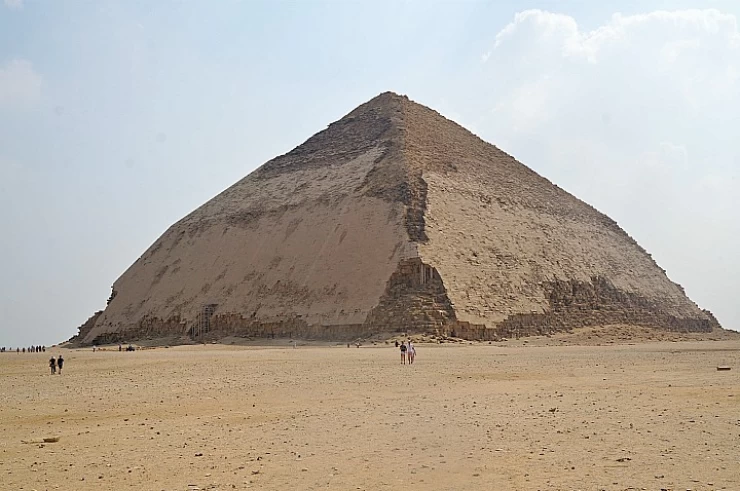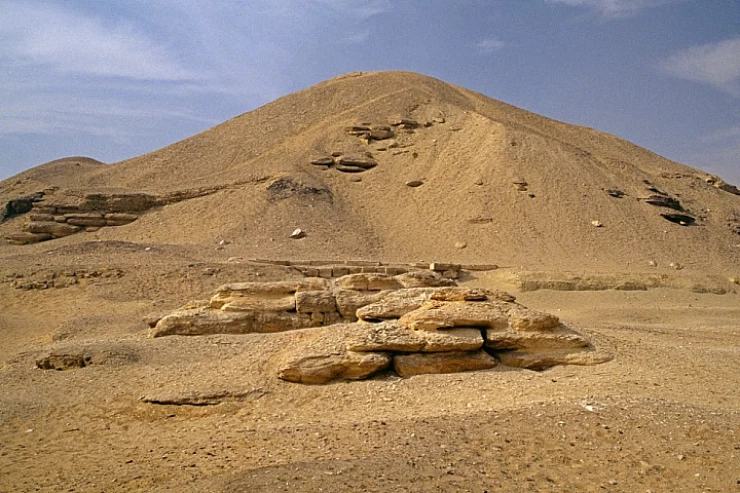
Dahshur Archaeological Site | Pyramid of Amenemhet III
Exploring the Enigmatic Dahshur Archaeological Site
Nestled along the western banks of the Nile River, approximately 40 kilometers south of Cairo, the Dahshur archaeological site stands as a monumental testament to ancient Egypt's architectural and engineering prowess. This significant location is renowned for its collection of pyramid structures, particularly those from the Old Kingdom period, offering a glimpse into the early evolution of pyramid construction.
Dahshur’s prominence in Egyptology primarily stems from its role as a royal necropolis during the Old Kingdom, specifically the Fourth Dynasty (circa 2613–2494 BCE). The site is most celebrated for its two remarkable pyramids—the Bent Pyramid and the Red Pyramid—both commissioned by Pharaoh Sneferu, who was a key figure in the evolution of pyramid design.
The Bent Pyramid
The Bent Pyramid, constructed around 2600 BCE, represents a crucial stage in the development of pyramid architecture. Its distinctive appearance is due to its unique angle: the lower portion of the pyramid was built at a steep angle of 54 degrees, while the upper section was constructed at a shallower angle of 43 degrees. This abrupt change in angle is believed to reflect architectural challenges faced during construction. The Bent Pyramid's structure suggests that the ancient builders may have encountered difficulties with the stability of the structure, prompting the adjustment in the angle to prevent collapse.
Despite these issues, the Bent Pyramid remains one of the best-preserved pyramids from the Old Kingdom. Its internal layout features a series of corridors and chambers, showcasing the complexity and ingenuity of early pyramid design.
The Red Pyramid
Nearby, the Red Pyramid, also built by Sneferu, stands as the first successful attempt at constructing a true, smooth-sided pyramid. Completed around 2590 BCE, this pyramid was originally clad in red Tura limestone, which gives it its distinctive hue. The Red Pyramid is named for the reddish color of the limestone, which has weathered over the millennia but still conveys a sense of grandeur.
The Red Pyramid is notable for its geometric precision and engineering innovation. Its construction marked a significant advancement in the design of pyramids, transitioning from the stepped structures of earlier periods to the smooth, angled form that became iconic in later pyramids. The Red Pyramid’s internal chambers and corridors are well-preserved, offering valuable insights into the burial practices and architectural techniques of the time.
Other Features of Dahshur
In addition to the Bent and Red Pyramids, the Dahshur site includes several other significant features:
The North Pyramid: Attributed to Pharaoh Amenemhat II of the Middle Kingdom, this pyramid was built with a distinctive design that reflects a shift in architectural styles. Though less well-preserved than its predecessors, it offers important clues about the evolution of pyramid construction.
The Pyramid of the Black Pyramid: Constructed by Pharaoh Amenemhat IV, this pyramid is characterized by its dark, weathered appearance, which contrasts with the more familiar bright limestone structures.
The Subterranean Structures: Dahshur also houses a series of underground tombs and burial shafts, providing evidence of the burial practices and religious beliefs of ancient Egyptians.
Dahshur Archeological Site, known to most, is situated on the Western bank of the Nile River, about 40 kilometers to the south of Greater Cairo, where it appears to draw less of the public’s attention compared to many of Egypt’s ancient sites. This exceptional site, which is less packed than the Giza Plateau, allows for a more personal understanding of the evolution of ancient Egyptian architecture. With some of the oldest and most distinct pyramids in the nation, Dahshur is proof of architectural innovation that used to exist before the making of the Great Pyramid.
The relative tranquility that Dahshur offers enables visitors to view these impressive edifices in a much more comfortable manner without falling into the unpleasant crush of other more popular attractions. Let us explain why this fascinating place should be included in your Egyptian tour program.
A Brief History of Dahshur
The relevance of Dahshur back to the Early Dynastic period, that is, the 4th Dynasty (circa 2613–2589 B.C.E.), during the reign period of Pharaoh Sneferu, who was the first ruler of the Old Kingdom of Egypt and Khufu’s father, the great pyramid builder at Giza. Known for his innovation in building structures, the Egyptian Pharaoh can be said to have used dahshur as his laboratory for the construction of pyramids.
This region has several pyramids, such as the bent pyramid and the red pyramid, both built for Sneferu the King of Egypt in the 4th Dynasty. Their shapes are quite interesting and differ from each other, resembling the stages of pyramid-building that developed to produce the famous pointed pyramids standing on the Giza plateau.
Near the Bent Pyramid is located the Red Pyramid, which is also a creation of Sneferu’s and is generally accepted as the earliest real smooth-sided pyramid ever built. This pyramid is named after the tinge of red that its limestone blocks have and is the third largest pyramid in Egypt with a height of 105 meters. Certainly impressive.
The Bent Pyramid may be said to be the best-known structure in Dahshur, and there is a good reason for this. The peculiarities of this pyramid lie in its shape that curves like a bend, with a miniature upward angle curve occurring at the halfway mark. It was first designed as a real pyramid with sharp surfaces at its sides, but the angle was changed halfway through the construction, most probably for the fact that there was a problem with the structure.
The Bent Pyramid rises in height to 104 meters and is sheathed in white limestone, which is largely well-preserved, giving a clear picture of what pyramids would have looked like when they were constructed. In the last few years, the Bent Pyramid has been the subject of much activity, and visitors have been allowed to view its inner chambers and labyrinth of passageways. Within, there are two tombs connected by a small hall lined with walls of limestone that still show the marks made by the chisels of the workers at the time.
a feat of engineering and a testament to the mastery of ancient Egyptian builders.
The Red Pyramid is notable for its nearly perfect smooth sides and the precision of its construction. Visitors are permitted to enter the pyramid and explore its interior, which includes a long descending passageway leading to three burial chambers. The pyramid’s acoustics and the faint scent of ancient stones lend a mystical atmosphere to the experience, offering an almost ethereal glimpse into Egypt’s distant past.
In addition to the pyramids erected by Sneferu, Dahshur further contains the Black Pyramid of Amenemhat III, which dates back to the Middle Kingdom period. Even though age has not spared this particular building, with its appearance now likened more to a dark, ruined lump than a pyramid, it still stands as an interesting relic of the architectural creativity that characterizes the area. In the first instance, the Black Pyramid was made with limestone and was buried in dark mud bricks, hence the background. It is believed the pyramid was built as a tomb for Pharaoh Amenemhat III, but it was not used for this purpose because it became unstable.
The Dahshur Necropolis: A Rich Tapestry of History
Dahshur's archaeological wealth is not limited to its pyramids. It is a very rich site that features a large cemetery filled with tombs, burial shafts, and other ancient structures that assist in understanding the ancient Egyptians’ views towards death. Many objects have been found on this site by archaeologists too, such as pots, ornaments, and instruments, some of which are kept in the Egyptian Museum in Cairo.
Dahshur in recent years was the subject of a number of archaeological campaigns that aimed at learning more about the area. The excavations opened more tombs and found more articles, which illustrated the way of life of the individuals who were born and buried within these grand constructions.
Accessibility and Location Dahshur is reachable by vehicle for a brisk one-day tour from Cairo. Most of the travelers traveling to Dahshur also make a visit to the neighboring areas of Saqqara and Memphis to make it a day full of ancient Egyptian history. The site is easily reached by car, and there are also organized tours that include transportation and a knowledgeable guide.
Tickets and entry fees are charged to these ancient wonders.
The introduction fee to enter the Dahsur site is quite minimal compared to that of the already congested pyramids at Giza. Entry is allowed not only to the Bent Pyramid but also to the Red Pyramid, enabling them to see the outside and the inside of these two ancient structures.
Best Time to Visit I think the most appropriate time for a tourist to visit Dahshur is in the cooler months of Egypt, which are from October to April. This is the season when there is moderate scenery that makes the exploration of the outdoor site and the climbing of the pyramids inside very interesting. Early visits are best to prevent exposure to excessive heat around noon and to have the site in low attendance.
What to Bring Light clothing and good walking shoes are advised as touring Dahshur involves a bit of walking and the inside of the pyramids is sometimes sloping steeply. Carry water and sun cream and preferably a torch if you are going to the chambers inside the pyramids because they are not always well-lit.
Guided Tours A visitor to Dahshur can, however, decide to visit the area without a guide, but it is highly recommended that an experienced guide be hired. A visitor may not only learn the history and importance of the pyramids and the site from the guide but also learn how to move within the pyramids themselves.


















